Virginia Woolf Writing Style
A Room of One’s Own is one of the most significant feminist texts of the twentieth century; modern female writers look to Virginia Woolf’s work for empowerment and literary inspiration. There are many occasions throughout this essay where it is obvious that Virginia Woolf is undoubtedly a distinguished and intelligent writer. From the very beginning, the text detours from conventional expectations of style and presentation; it seems that Woolf is intentionally contradicting to the writing status quo of the 1900’s as she writes about women, fiction, and a literal and metaphorical room of one’s own.
Throughout the following paper, the effects and accomplishments of Virginia Woolf’s unique writing style, in particular her use of atypical paragraphs and long sentences, will be presented and examined.
Before analyzing the intricate and unfamiliar style of Virginia Woolf’s writing, it is beneficial to understand the purpose and context of her words. A Room of One’s Own seems to be an inner dialogue where Woolf mainly presents her ideas and opinions.
For example, consider the three opening lines of the essay, “But, you may say, we asked you to speak about women and fiction-what has that got to do with a room of one’s own? I will try to explain” (3). The use of the first person pronoun so early into the essay clearly illustrates that the text consists of her thoughts, her feelings, and her views. This bold statement and unique narrative use within the first few lines of the essay could be interpreted as Woolf’s attempt to imply that it is her essay and that she will make it what she wants it to be; no one, particularly no man, will confine her writing style.
On the other hand, these opening lines could also be construed as Woolf’s proclamation that she will use her knowledge and past experiences to explain how women and fiction are related to having a room of one’s own. Regardless of the interpretation, the point is immediately made that only Woolf’s ideas and opinions will be presented in the literary offering; the text is strictly a female writer’s approach to connecting three different, yet significant topics.
Writing Style Essay
In addition to being a first person narrative, another aspect of the text worthy of mentioning, prior to analysis of the style, is the fact that Woolf’s ideas and opinions do not represent a final word on any issue, but instead initiate a debate. Woolf never comes to an obvious conclusion on any of her major topics, she seems to be, more or less, prodding at the minds of the young women she is presenting to, igniting a desire in them to know more about women and fiction, and perhaps a bit more about themselves, as she writes:
All I could do was to offer you an opinion upon one minor point-a woman must have money and a room of her own if she is to write fiction and that, as you will see, leaves the great problem of the true nature of woman and the true nature of fiction unsolved. I have shirked the duty of coming to a conclusion upon these two questions-women and fiction remain, so far as I am concerned, unsolved problems (4).
Moreover, throughout the essay, it is obvious that Woolf wholeheartedly believes that women should be different from men. On page 88, she avows, “…it would be a thousand pities if women wrote like men, or lived like men, or looked like men.” Is it plausible that Virginia Woolf sways from the conventional manly style of writing in the twentieth century, because she believes that women should not write using the same form as men? Consider her opinion that women must maintain individuality in their experiences as writers, as she asks Mary Carmichael:
“…are Jane Austen’s sentences not the right shape for you? Must they all be scrapped because Emma and Mr. Woodhouse are dead? Alas, I sighed, that it should be so. For while Jane Austen breaks from melody to melody as Mozart from song to song, to read this writing was like being out at sea in an open boat. Up one went, down one sank. This terseness, this shortwindedness, might mean that she was afraid of something; afraid of being called “sentimental” perhaps; or she remembers that women’s writing has been called flowery and so provides a superfluity of thorns; but until I have read a scene with some care, I cannot be sure whether she is being herself or some one else (80-1).
Virginia Woolf Writing Style. (2019, Dec 05). Retrieved from https://paperap.com/paper-on-decoding-and-interpreting-virginia-woolfs-writing-style/

